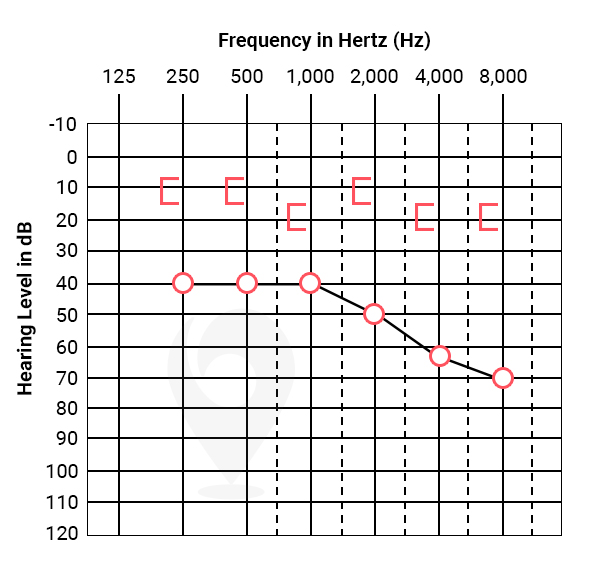Conductive Hearing Loss
Causes, symptoms, treatment options
About 15% of adults in the United States report that they have trouble hearing.
Over 90% of those individuals have what is called sensorineural hearing loss, or, what most people think of as “normal” hearing loss, usually due to aging or a lifetime of exposure to loud noises.
Much less common, is conductive hearing loss.
If you have a conductive hearing loss instead of - or in addition to - sensorineural hearing loss, you need to take a different approach to managing your hearing loss.
In this post we’ll explain some of the causes and symptoms of conductive hearing loss, along with the most popular treatment options.
What is conductive hearing loss?
The answer is in the name.
If you have a conductive hearing loss, that means sound has trouble conducting (transmitting) from the air around you into your ear.
Essentially, something blocks the path of sound to your inner ear, such as ear wax or fluid from an infection.
In order for this to make sense, let’s first review how hearing works.
How we hear

- The outer ear collects sound from around you - like a funnel - and directs it into your ear canal.
- Sound travels down your ear canal until it hits your eardrum and makes the eardrum vibrate.
- As a result of the eardrum vibration, the ossicles (little bones) vibrate.
- The ossicle vibration then causes the fluid inside the cochlea to vibrate.
- The fluid vibration inside of the cochlea activates hair cells that send signals to the brain via the auditory nerve.
With conductive hearing loss, you have a problem somewhere along steps 1 through 4.
In a normal ear, all of the parts along steps 1 through 4, including the ear canal, eardrum, and ossicles, are designed to make sure that sound reaches the inner ear (cochlea) in an efficient manner.
The various parts of the outer and middle ear employ physics to make the sound energy travel better than it would if it simply traveled directly to the cochlea through air.
As an analogy, think of a game that you might have played as a kid, making a telephone out of string and two cups.
Sure, you could simply shout to your friend through the air, but the string and cups makes your voice travel more easily through the air.
The parts of the outer and middle ear are similar to the string in that they make it easier for sound to get from the outer ear to the inner ear.
When the eardrum has a hole in it, or you have wax in the ear canal, or there’s a problem with the middle ear, sounds around you can’t get to the cochlea with the same energy level- they aren’t conducted as they should be.
How to know if you have a conductive hearing loss
You may have a conductive hearing loss if you experience any of these symptoms, but the only way to know for sure is to get a hearing test.
The main purpose of the hearing test, aside from measuring your overall hearing ability, is to determine the type of hearing loss you have.
In order to do that, your hearing care provider is going to administer a few tests, which essentially aim to determine (or make an educated guess), as to where in the 5 step process
the problem is occurring.
Your hearing care provider will want to find out if the problem exists somewhere in the ear canal or middle ear, in conducting the sound to your inner ear, or if the problem exists in the cochlea or auditory nerve, sending that signal to your brain.
The way we isolate where the breakdown is occurring, is by performing two types of hearing tests: air conduction testing and bone conduction testing.
Air conduction testing is the test where your hearing care professional places a set of headphones over or in your ears. You have to raise your hand or press a button when you hear a beep. The beeps have to travel through your entire ear - down your ear canal, through the eardrum and the ossicles, and through the cochlea and the nerve - for you to hear them. When most people think of getting a hearing test, this is what they think of, and it’s the kind that almost all of us are given periodically in elementary school.
Bone conduction testing is the test where your hearing care professional places a metal headband on your head, with a black vibrator that fits behind one of your ears. You have to raise your hand or press a button when you hear a beep. The vibrator sends sound into your cochlea by vibrating the bone behind your ears. This sound travels directly into the cochlea, bypassing the ear canal and eardrum.
If you’re following along, you can probably see why bone conduction testing is necessary, and what it tells us.
To recap, air conduction testing measures your hearing the traditional way- it sends sound through your ear canal and measures your natural ability to hear that way.
Bone conduction bypasses that natural process, and sends sound directly to the cochlea.
So, if your test results show that you heard better via bone conduction than air conduction what do you think that means?
Usually if the bone conduction scores are better than the air conduction scores, it means there is something in the ear canal or middle ear which is preventing the transmission of sound before it gets to the cochlea. Or in other words, the sound is somehow being “dampened” when it travels the usual route.
So when your hearing care provider looks at your test results, one of the primary things they are looking at is if there is a difference in how you hear with these two kinds of testing.
If you hear better by bone conduction, part of your hearing loss results from blockage of sounds from getting into your ear and traveling to the cochlea. You have a conductive hearing loss.
In other words, sounds have to be louder for you to hear them when we send the sounds down the normal pathway through your ear canal and eardrum.
The chart (audiogram) below, which is where your test results are recorded, shows what a discrepancy between bone conduction and air conduction scores may look like.

If there is no difference between air conduction and bone conduction, your hearing loss is probably sensorineural.
What is mixed hearing loss?
Mixed hearing loss is what it sounds like: a mixture of both conductive and sensorineural hearing loss.
For example, you might have a typical sensorineural hearing loss from getting older, but one day you get an ear infection.
The ear infection causes an additional conductive hearing loss that’s on top of your usual sensorineural hearing loss.
If you have a hearing test that day, you will show a mixed hearing loss.
Your total hearing loss on the audiogram is a combination of your pre-existing sensorineural hearing loss and your additional conductive loss.
If you have a mixed hearing loss, you may be able to improve your hearing with medical treatment for the conductive component of the loss.
Causes of conductive hearing loss
The most common cause of conductive hearing loss in adults is simply ear wax.
Ear wax is a normal body substance, but it can build up when people use cotton swabs that push the wax down the ear canal.
Older people, who have dental problems and have changes to their skin with age, tend to get impacted ear wax.
Other, more complex problems that lead to conductive hearing loss include:
| External ear causes | Middle ear causes |
|---|---|
| Wax | Otitis media (ear infection) |
| Otitis externa (swimmer's ear) | Middle ear mass |
| Malformation of outer ear and auditory canal | Foreign body in middle ear |
| Foreign body/mass in ear canal | Poor Eustachian tube function |
| Tympanic membrane (eardrum) perforation | Middle ear malformations |
Symptoms of conductive hearing loss
When you have conductive hearing loss, sounds around you are softer and muffled.
Depending on the problem that has caused the conductive hearing loss, you may also experience:
- Tinnitus (ringing in the ears)
- Dizziness
- Pain
- Ear drainage
- A feeling of ear fullness
In many cases, these symptoms will resolve once the underlying cause of the conductive hearing loss has been medically treated.
Treatment options
The first treatment option is to fix the cause of the hearing loss, if possible.
So, if you have a wax blockage, you can have a doctor remove it for you.
If you have an ear infection, you can see a doctor for treatment.
Some causes of conductive hearing loss are more complicated, and require surgery.
For example, if you have a hole in your eardrum, or damage to your middle ear bones, an Ear, Nose, and Throat (ENT) surgeon may be able to fix it with a procedure.
Common ENT procedures for conductive hearing loss include:
- Patching a hole in your eardrum (myringoplasty or tympanoplasty)
- Reconstructing or replacing your middle ear bones (stapedectomy or ossiculoplasty)
- Placing a pressure equalizing tube in your eardrum to prevent ear infections
- Surgical removal of cholesteatoma, a kind of middle ear tumor
Sometimes, the problem cannot be fully fixed with surgery, or you may choose not to have an operation.
Operations may be more risky than helpful if you’re in poor health or have other medical conditions.
The best professional to give you advice on surgical and medical treatment of conductive hearing loss is an ENT doctor.
The ENT doctor and you may decide not to do surgery, or surgery may only partially restore your hearing.
In this case, getting hearing aids is an option.
If you decide to get hearing aids, you will want to consult with a hearing healthcare professional who has experience fitting hearing aids to conductive hearing loss.
The fitting strategies for conductive hearing loss are different from those for “typical” sensorineural hearing loss.
You want to work with a knowledgeable provider who listens to you and programs hearing aids to suit you.
Conclusion
If you’re concerned that you might have a conductive hearing loss, you should contact a hearing care provider in your area for an exam.
The hearing care provider can confirm your suspicions, and refer you to a medical doctor for treatment if needed.
If it turns out that medical or surgical treatment options for your hearing loss are limited, than the hearing care provider can work with you to identify hearing aid options.
It’s important to see a hearing care professional promptly if you experience conductive hearing loss, so that any medical problems like infections can be addressed before they worsen.






